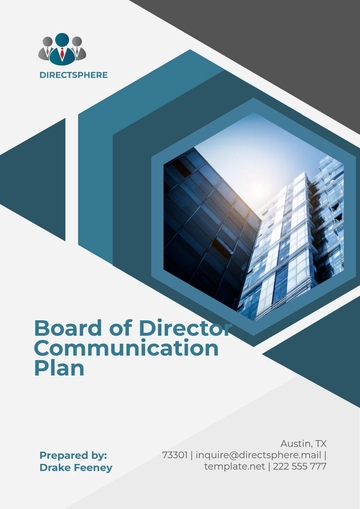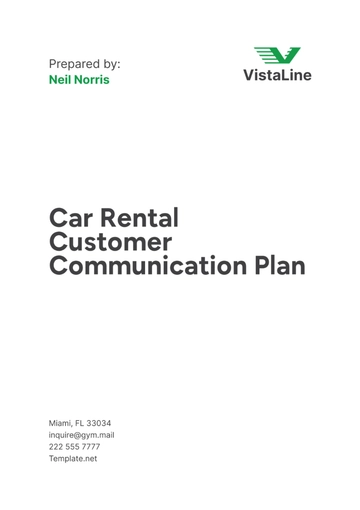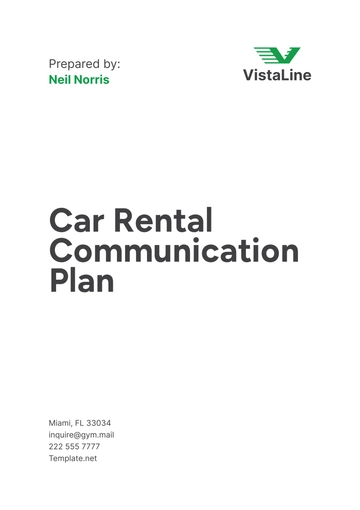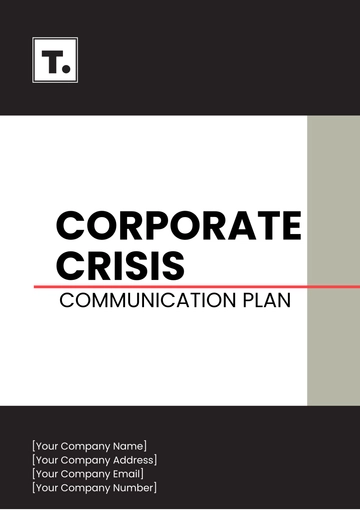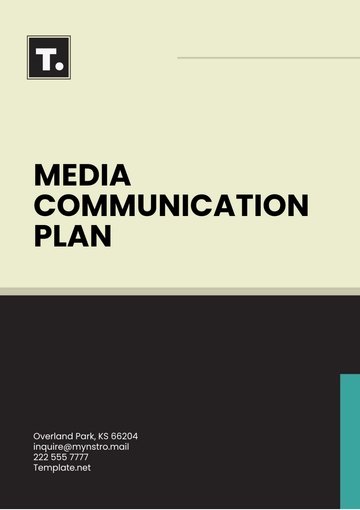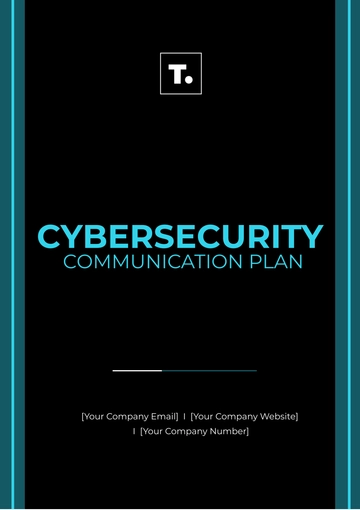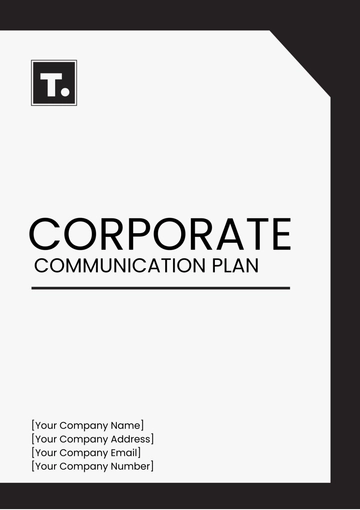Free Climate Change Communication Plan

I. Executive Summary
As [Your Company Name] strives towards achieving its climate change goals by 2055, this communication plan outlines how we will effectively engage our stakeholders through transparent and proactive communication. The plan will focus on clearly conveying our actions, results, and next steps in sustainability, while also highlighting the importance of collaboration to address climate change. By ensuring timely and impactful communication, we aim to not only inform but also inspire positive actions towards a sustainable future.
II. Objectives
A. Raise Awareness of Climate Initiatives
We aim to raise awareness of our sustainability initiatives by [00]% by 2055, focusing on educating our stakeholders about our efforts to reduce carbon emissions, conserve resources, and adopt sustainable practices. This will be achieved through multi-channel communication strategies that showcase our milestones and share the impacts of our initiatives. Additionally, we will foster a culture of environmental responsibility across all levels of the company, empowering our employees to act as climate change advocates.
B. Engage Stakeholders in Climate Action
Our engagement goal is to involve at least [00]% of our customers, employees, and partners in climate action by 2055. This will include offering educational resources, rewards programs for sustainable behavior, and creating opportunities for stakeholders to participate in sustainability-related events and challenges. Our communication efforts will focus on building a sense of shared responsibility, ensuring stakeholders understand the critical role they play in achieving our long-term goals.
C. Enhance Transparency and Reporting
Transparency in our sustainability performance is essential for maintaining trust with our stakeholders. By 2055, we will provide detailed annual sustainability reports, incorporating real-time data, key performance indicators (KPIs), and clear action plans to demonstrate our progress toward carbon neutrality. Additionally, our website will feature an interactive dashboard that allows stakeholders to monitor our environmental performance, fostering a sense of accountability and trust.
III. Target Audiences
A. Internal Audiences
Employees
We will provide regular updates to our employees through emails, intranet posts, and workshops, ensuring they are informed about our sustainability initiatives. Employees will be encouraged to participate in internal challenges, such as reducing personal carbon footprints or contributing ideas for new sustainability projects. Engagement and ownership among employees will be key to the success of our climate change goals.
Management and Executives
It is crucial that our leadership team is aligned with our climate change communication efforts. We will organize quarterly briefings with management to discuss progress, challenges, and opportunities, ensuring they are well-informed and motivated to lead by example. Our executives will also play a role in representing our climate goals to external stakeholders and reinforcing the importance of sustainability in all corporate decisions.
Shareholders and Investors
For our shareholders and investors, we will provide transparent, data-driven sustainability reports during annual general meetings (AGMs) and in quarterly updates. These communications will outline the financial benefits of our climate initiatives, demonstrating how sustainability leads to long-term profitability. We will also engage them through targeted one-on-one meetings to ensure their concerns are addressed, fostering a deeper understanding of our climate goals.
B. External Audiences
Customers
Our customers are a vital part of our climate strategy. Through our website, social media channels, and packaging, we will communicate our commitment to sustainability and share how our products contribute to environmental well-being. We will also encourage customers to take part in our sustainability initiatives, such as recycling programs or eco-friendly product choices, and provide them with incentives to adopt green behaviors.
Industry Peers and Partners
Collaborating with industry peers and partners will amplify our impact on climate change. We will engage with other organizations through sustainability-focused industry events, joint initiatives, and shared research projects to drive collective action. Additionally, we will actively participate in trade associations to promote industry-wide standards for environmental sustainability and best practices.
Local Communities
Our local communities will benefit from our climate efforts, and we will build strong relationships by engaging them in environmental education programs, tree-planting initiatives, and community sustainability challenges. By partnering with local environmental organizations, we will amplify our climate change messages and help foster a culture of sustainability in the regions where we operate. Our commitment to local communities will also include supporting green infrastructure projects and contributing to climate resilience initiatives.
Media
Media will play a crucial role in spreading our climate change messages. We will work closely with journalists and editors to secure coverage of our sustainability initiatives, key milestones, and community efforts. Regular press releases and media interviews will ensure that our climate action plan receives the attention it deserves, helping to shape public perception and build awareness around our efforts.
IV. Key Messages
A. Commitment to Sustainability
“We are committed to achieving carbon neutrality by 2055 and reducing our emissions by [00]% by 2040. Our actions are guided by the urgency of addressing climate change and the responsibility we have to future generations.” Our goal is to create an environmentally sustainable business model that will positively impact not only our operations but also the global community.
B. Carbon Reduction Targets
“We have successfully reduced our carbon footprint by [00]% since 2020 and are on track to meet our ambitious target of [00]% reduction by 2040. This milestone is a testament to the power of collaboration and innovation in achieving sustainability.” We will continue to pursue renewable energy sources, optimize our production processes, and implement green technologies to further reduce our impact on the planet.
C. Call to Action
“We encourage our stakeholders, from employees to customers, to join us on this journey. Together, we can make a significant difference in creating a sustainable and resilient future. Your actions, no matter how small, contribute to a global movement for positive change.”
V. Communication Channels
A. Internal Communication
Employee Intranet | Our intranet will serve as the central hub for sharing updates on sustainability efforts, offering resources such as guides on reducing personal carbon footprints, and promoting sustainability-focused training programs. |
Town Hall Meetings | These meetings will provide employees with direct access to senior leadership, enabling them to ask questions and participate in discussions about climate initiatives. We will host these sessions quarterly to ensure continuous dialogue and engagement. |
Emails & Newsletters | Our monthly sustainability newsletters will highlight achievements, provide actionable tips for employees, and showcase success stories from our teams across different departments. We will use these communications to celebrate milestones and encourage ongoing participation in our climate action programs. |
B. External Communication
Social Media | We will leverage platforms like Twitter, LinkedIn, Instagram, and Facebook to share progress on our sustainability goals, engage in conversations with followers, and raise awareness about key initiatives. These platforms will allow us to connect with younger, more environmentally conscious audiences. |
Website | Our website will feature an interactive sustainability dashboard that showcases our carbon footprint, energy use, and environmental impacts in real-time. This dashboard will be accessible to the public and updated regularly to ensure transparency and accountability. |
Press Releases | Press releases will be used to announce significant milestones, new partnerships, and climate-related awards or recognition. These will be distributed to key media outlets and stakeholders to ensure broad visibility and coverage. |
VI. Content Strategy
A. Data and Metrics
To effectively convey our progress, we will use detailed metrics, including percentage reductions in carbon emissions, energy use, and waste. Interactive charts and graphs will be embedded in online reports to help stakeholders visualize our progress in real-time. Our sustainability website will also feature a tool that allows users to calculate their own carbon footprints and compare them with our company-wide goals.
B. Success Stories and Case Studies
Success stories will feature detailed case studies of successful sustainability projects, such as the installation of renewable energy systems at our manufacturing plants or community-based reforestation efforts. These stories will be shared across multiple platforms, including our website, social media, and newsletters, to demonstrate the tangible impact of our initiatives.
C. Visual Assets
We will develop infographics, videos, and animations that simplify complex data and make it more digestible for a wide range of audiences. These visual assets will be designed to enhance the emotional appeal of our climate change messages, highlighting both the challenges and opportunities of transitioning to a sustainable future.
VII. Timeline and Frequency
A. Timeline Overview
This communication plan will roll out over the next five years, with annual sustainability reports, quarterly newsletters, and monthly updates. Major milestones, such as the launch of new sustainability initiatives, will be communicated promptly through press releases and social media announcements.
B. Communication Frequency
To maintain momentum and engagement, updates will be shared at least quarterly via emails, newsletters, and town hall meetings. Social media platforms will be updated on a weekly basis to keep followers informed and engaged.
C. Milestones
Milestone | Date | Description |
|---|---|---|
Carbon Reduction by 40% | Q2 2052 | Achieved 40% reduction in emissions |
Launch of Sustainability Report | Q4 2053 | Publicly share detailed report |
Carbon Neutrality Target | Q4 2055 | Achieve carbon neutrality |
VIII. Roles and Responsibilities
A. Sustainability Team
The Sustainability Team will oversee the strategic execution of the communication plan, ensuring that all actions align with the organization’s environmental goals. This team will collaborate with various departments to collect relevant data, develop key messages, and identify communication opportunities. They will also monitor the effectiveness of the plan, adjusting strategies when necessary to maximize impact and reach.
B. Communications Team
The Communications Team will be responsible for crafting, designing, and disseminating all messaging related to climate change initiatives. They will work closely with the Sustainability Team to ensure the accuracy and consistency of content across all communication channels. In addition to day-to-day content creation, they will also manage public relations efforts, media outreach, and crisis communication when needed.
C. Leadership
Leadership will play a critical role in endorsing the sustainability strategy and communicating the company’s commitment to climate action both internally and externally. Executives will be the public-facing voice of the company, providing leadership in industry forums, public engagements, and interviews. They will also lead by example, demonstrating their commitment through sustainable business practices and transparent reporting.
IX. Evaluation and Metrics
A. Key Performance Indicators (KPIs)
To track the effectiveness of the communication plan, we will measure metrics such as stakeholder engagement, media coverage, and overall public sentiment towards our sustainability efforts. Specific KPIs will include social media engagement rates, the number of stakeholder interactions, and the level of website traffic related to climate content. These indicators will help identify areas of improvement and fine-tune future communications.
B. Methods of Evaluation
We will utilize advanced analytics tools to assess the performance of our digital content across all channels, including website traffic, social media metrics, and engagement with our sustainability reports. Regular surveys and focus groups will provide qualitative data to gauge stakeholder perceptions and their understanding of our climate initiatives. We will also conduct periodic reviews of our media coverage to assess public awareness and sentiment toward our climate goals.
C. Feedback Mechanisms
Feedback from employees, customers, investors, and other stakeholders will be actively sought through surveys, polls, and interactive platforms. We will integrate this feedback into future updates to the communication plan, ensuring that we are responsive to stakeholder concerns and expectations. Additionally, feedback will be used to enhance future content, making it more accessible and relevant to diverse audiences.
X. Crisis Communication Plan
A. Potential Risks
The most common risks include failure to meet carbon reduction targets, negative media coverage regarding sustainability practices, and external events such as policy changes that may affect our operations. In the event of a public relations crisis or any setbacks, our priority will be to communicate honestly, quickly, and clearly with all stakeholders. We will also ensure that the broader public is aware of our commitment to taking corrective actions.
B. Pre-Approved Messaging
Pre-approved messaging will be drafted to ensure that our response is timely, consistent, and maintains public trust. For instance, if emissions targets are not met on schedule, the pre-approved message could state, “We recognize that we are facing challenges in achieving our goal, but we are fully committed to correcting course and will provide regular updates on our progress.” This messaging will focus on transparency, accountability, and a commitment to long-term success.
C. Crisis Management Team
The Crisis Management Team will consist of key personnel from communications, sustainability, legal, and executive leadership. This team will have predefined roles to manage the swift dissemination of crisis communication and ensure that all messaging is aligned with the company’s values and long-term objectives. They will also be responsible for evaluating the crisis’s impact on stakeholders and adjusting the communication strategy accordingly to mitigate any damage to the company’s reputation.
XI. Budget and Resources
A. Estimated Budget
The communication plan will require an estimated $[00] investment over the next five years, which will cover expenses related to digital content creation, advertising, media relations, and employee engagement programs. This budget will be allocated toward specific activities such as video production, paid social media campaigns, and sustainability reporting platforms. It will also include funds for staff, external consultants, and any technology needed to track and report on sustainability goals.
B. Resource Allocation
Resource allocation will prioritize areas that have the highest impact on communication effectiveness. The breakdown of funding will include:
Activity | Estimated Cost |
|---|---|
Social Media Campaigns | $150,000 |
Content Creation (Graphics, Video) | |
Press Outreach & Media Relations | |
Employee Engagement Programs |
This allocation ensures that funds are distributed where they will drive the most engagement, visibility, and results for the company’s sustainability communications.
- 100% Customizable, free editor
- Access 1 Million+ Templates, photo’s & graphics
- Download or share as a template
- Click and replace photos, graphics, text, backgrounds
- Resize, crop, AI write & more
- Access advanced editor
Make your climate change communication strategy effortless with the Climate Change Communication Plan Template from Template.net. This fully editable and customizable template allows you to easily tailor your plan to meet your unique needs. Leverage the powerful AI Editor Tool for seamless content adjustments, ensuring your messaging is clear, effective, and aligned with your sustainability goals.



